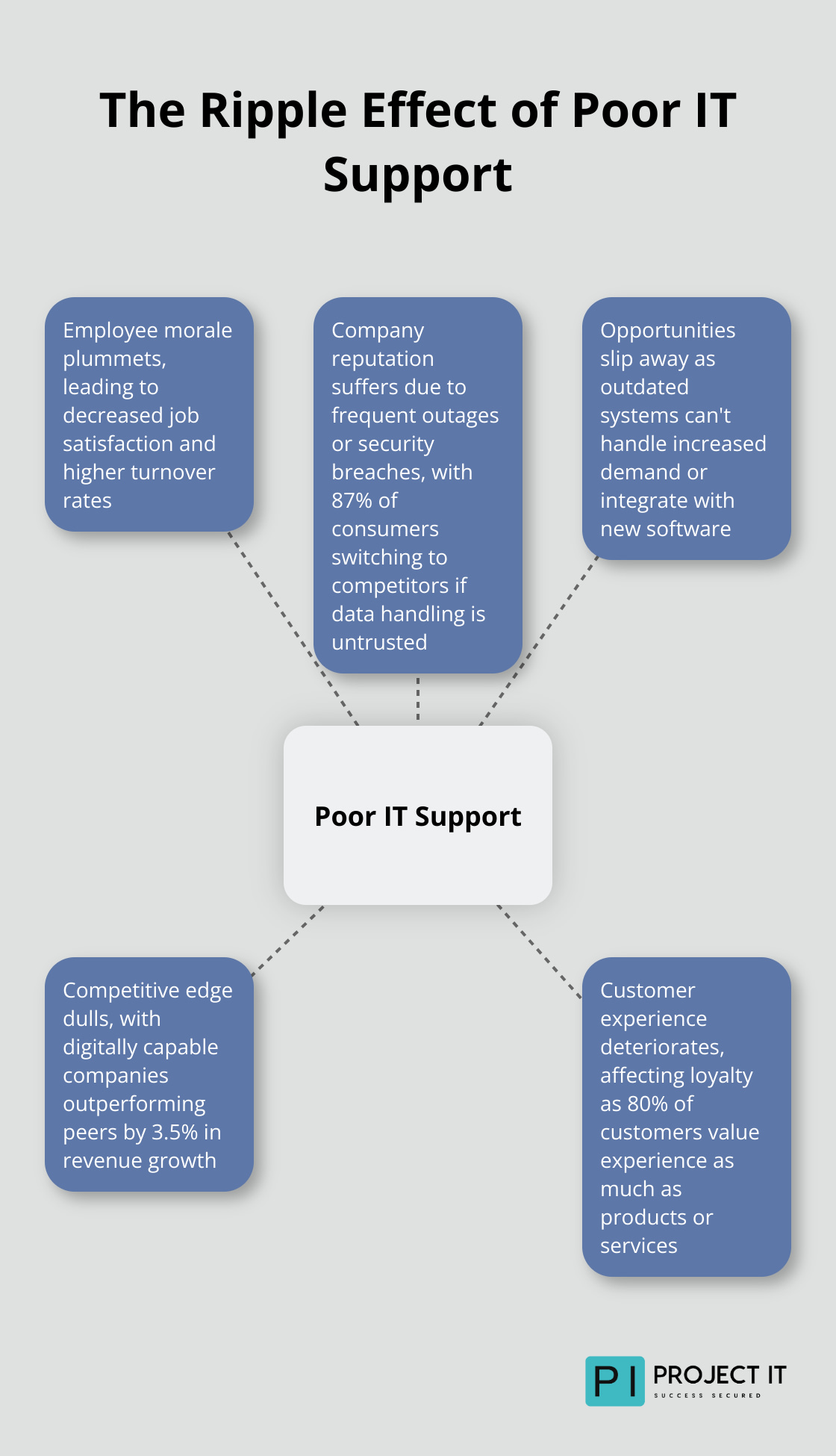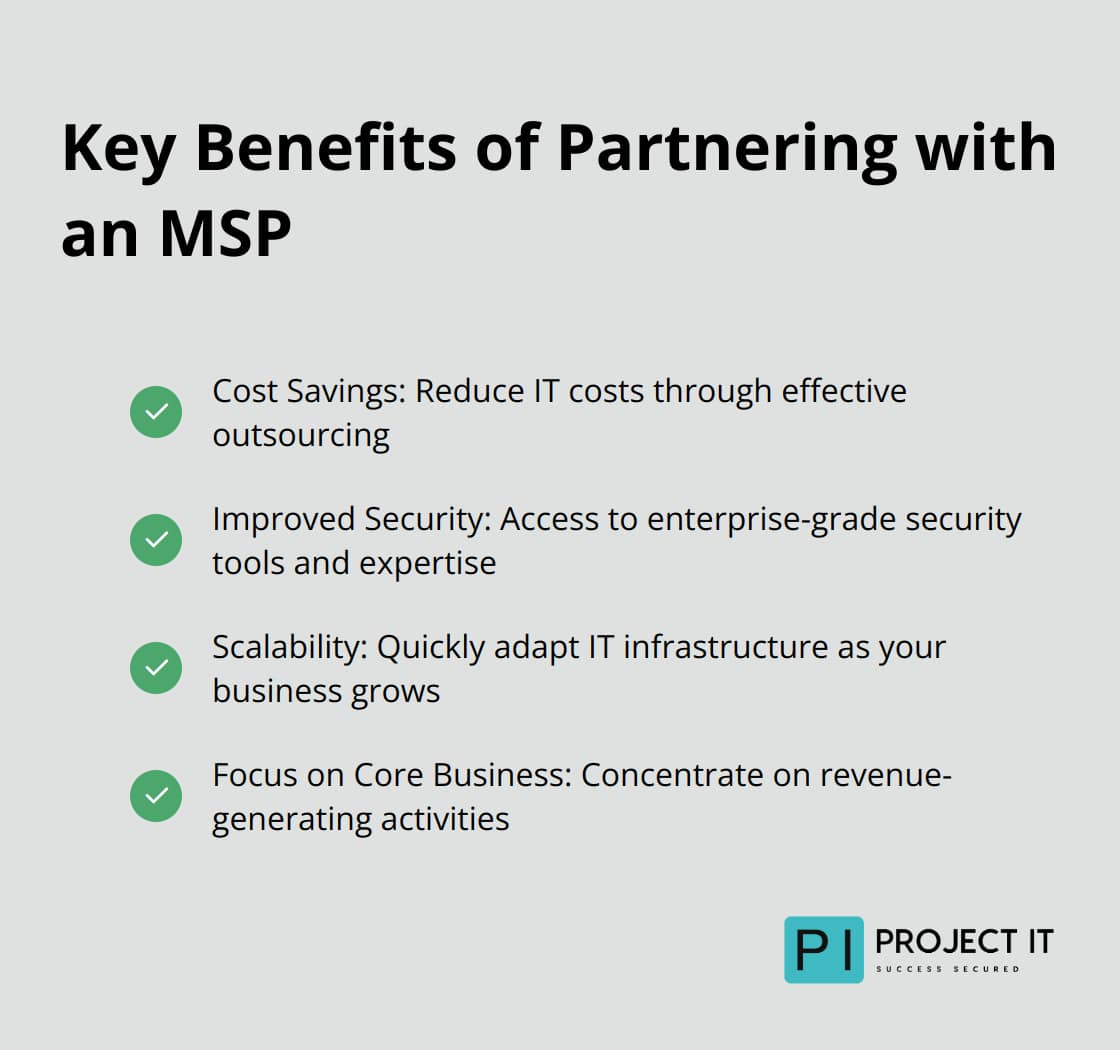Poor IT support can be a silent killer for businesses, draining resources and hampering growth. At Project IT, we’ve seen firsthand how inadequate tech assistance can lead to unexpected financial burdens and long-term consequences.
This post uncovers the true cost of subpar IT support and offers practical strategies to protect your business. We’ll explore both direct and indirect impacts, helping you make informed decisions about your IT investments.
The Real Price of Poor IT Support
Downtime Drains Your Bottom Line
IT outages kill profits. Gartner reports that downtime costs average $5,600 per minute. Large enterprises (especially in finance or e-commerce) can lose over $1 million per hour. Even smaller businesses face average downtime costs of $427 per minute in 2024. These figures represent lost sales, wasted wages, and missed opportunities.

To combat this, businesses should implement robust monitoring tools (like Splunk or New Relic). These solutions identify issues before they escalate into full-blown outages. Investing in redundant systems and a solid disaster recovery plan can also significantly reduce the risk and impact of unexpected downtime.
The Hidden Costs of Repairs and Replacements
Poor IT support often creates a cycle of frequent repairs and premature equipment replacements. This incurs direct costs and disrupts operations. For example, a server failure due to neglected maintenance could cost tens of thousands in emergency repairs and lost productivity.
Businesses should adopt a proactive maintenance approach. Regular system checks, timely updates, and strategic hardware refreshes can extend the life of IT infrastructure and prevent costly breakdowns. It’s also crucial to partner with an IT provider that offers transparent pricing and comprehensive support plans to avoid unexpected expenses.
Data Breaches: A Financial Nightmare
The cost of a data breach extends far beyond immediate financial losses. IBM’s Cost of a Data Breach Report 2024 shows the global average cost of a data breach increased 10% over the previous year. This includes expenses related to detection, response, notification, and post-breach recovery.
Moreover, businesses face potential regulatory fines, legal fees, and long-term revenue declines due to reputational damage. Meta’s €1.2 billion fine for GDPR violations in 2024 serves as a stark reminder of the financial risks associated with inadequate data protection.
To mitigate these risks, businesses should implement robust cybersecurity measures such as multi-factor authentication, regular security audits, and employee training programmes. Additionally, partnering with a managed IT service provider can ensure expert support in maintaining compliance and responding swiftly to potential threats.
The Ripple Effect on Employee Productivity
Poor IT support doesn’t just affect systems; it impacts people. Employees who struggle with tech issues waste valuable time and experience increased frustration. This leads to decreased productivity and can even contribute to higher turnover rates.
A study by Robert Half Technology found that employees waste an average of 22 minutes per day dealing with IT-related issues. That’s nearly two hours per week or 91 hours per year of lost productivity per employee. For a company with 100 employees, this translates to 9,100 hours of wasted time annually.
To address this, companies should invest in user-friendly systems, provide comprehensive IT training, and ensure quick response times for tech support. This approach not only boosts productivity but also improves employee satisfaction and retention.
As we’ve seen, the costs of poor IT support extend far beyond simple repair bills. In the next section, we’ll explore the long-term consequences that can have an even more profound impact on your business’s success and sustainability.
The Ripple Effect of Poor IT Support
Employee Morale Plummets
Inadequate IT support erodes staff morale. A recent Zendesk study revealed key insights into customer service trends. This frustration decreases job satisfaction and often leads to higher turnover rates.
User-friendly systems and comprehensive IT training can significantly boost employee morale. Quick response times for tech support are essential. A partnership with a managed IT service provider (like Project IT) ensures your team always has expert help available.
Reputation Suffers
In our digital age, IT infrastructure forms the backbone of customer interactions. Frequent outages or security breaches severely damage a company’s reputation. A 2024 PwC survey showed that 87% of consumers will switch to competitors if they don’t trust a company to handle their data responsibly.
To safeguard your reputation, invest in robust cybersecurity measures and reliable IT systems. Regular security audits, employee training programmes, and collaboration with a reputable IT service provider are key steps to protect your company’s image.
Opportunities Slip Away
Subpar IT infrastructure causes businesses to miss growth opportunities. Slow systems can’t handle increased demand during peak seasons. Outdated technology might not integrate with new, potentially game-changing software.
A recent Deloitte report projects that global IT spending will grow by 9.3% in 2025, with data centre and software segments expected to grow at double-digit rates. This fact underscores the importance of current and scalable IT systems.
Competitive Edge Dulls
Poor IT support hampers innovation and agility. When your team spends time troubleshooting basic tech issues, they can’t focus on strategic initiatives that drive your business forward. This lack of innovation allows competitors to gain an advantage.
A study by McKinsey & Company (2024) found that companies with strong digital capabilities outperformed their peers by 3.5% in revenue growth. This statistic highlights the direct link between IT performance and business success.
Customer Experience Deteriorates
Unreliable IT systems often translate to poor customer experiences. Slow websites, unresponsive customer service channels, and data inaccuracies frustrate customers and damage loyalty. A 2024 Salesforce study revealed that 80% of customers consider their experience with a company as important as its products or services.
To address these challenges, businesses must prioritise IT support as a core component of their customer experience strategy. This approach includes investing in robust customer relationship management (CRM) systems, ensuring website performance, and implementing efficient communication tools.
The consequences of poor IT support extend far beyond immediate technical issues. They permeate every aspect of your business, from employee satisfaction to customer loyalty. In the next section, we’ll explore effective strategies to mitigate these risks and build a strong IT foundation for your company’s future.
How to Protect Your Business from IT Support Risks
At Project IT, we have observed how proactive strategies shield businesses from the pitfalls of poor IT support. Let’s explore practical steps you can take to safeguard your operations and boost your bottom line.
Implement Proactive Maintenance
Don’t wait for systems to fail. Put a robust preventative maintenance plan in place. This approach can reduce downtime significantly. Schedule regular health checks, updates, and performance optimisations. Use monitoring tools to catch issues before they escalate.
Set up automated patch management to keep all systems current. This simple step can prevent many security breaches. Also, consider predictive maintenance techniques. These use data analytics to forecast when equipment is likely to fail, allowing for timely interventions.
Prioritise Continuous Employee Training
Your staff forms your first line of defence against IT issues. A well-trained team can resolve many problems independently, reducing support calls and downtime. Put a comprehensive, ongoing training programme in place. This should cover basic troubleshooting, cybersecurity best practices, and the efficient use of your specific IT tools.
Try adopting a learning management system (LMS) to deliver and track training. These platforms can increase training completion rates compared to traditional methods. Also, consider gamifying the learning process to increase employee engagement with training materials.
Choose a Reliable Managed IT Service Provider
Outsourcing to a trusted IT partner can transform your business. A quality managed service provider (MSP) brings expertise, resources, and 24/7 support that most businesses can’t maintain in-house. When selecting an MSP, look for one with a proven track record in your industry and a comprehensive service offering.
Project IT offers a full suite of services including advanced cybersecurity, cloud solutions, and virtual CIO services. This holistic approach ensures all your IT needs are covered under one roof, simplifying management and reducing costs.
Key benefits of partnering with an MSP include:

The right IT support isn’t just about fixing problems–it’s about preventing them and driving your business forward. These strategies lay the foundation for sustainable growth and success in our digital world.
Final Thoughts
Poor IT support affects every aspect of your business, from employee productivity to customer satisfaction. Downtime, data breaches, and inefficient systems lead to financial losses, missed opportunities, and reputational damage. Quality IT support is a strategic investment that drives your business forward.
We recommend you assess your current IT infrastructure and support systems to identify weaknesses. Develop a plan to address these issues and consider partnering with a trusted IT support provider. This approach will help you access expertise and resources to transform your technology landscape.
Project IT offers comprehensive IT support solutions tailored to your unique business needs. Our expert team can help you navigate modern technology complexities, ensure robust security, and improve operational efficiency. Explore how we can support your business’s success and help you stay ahead in today’s competitive landscape.


